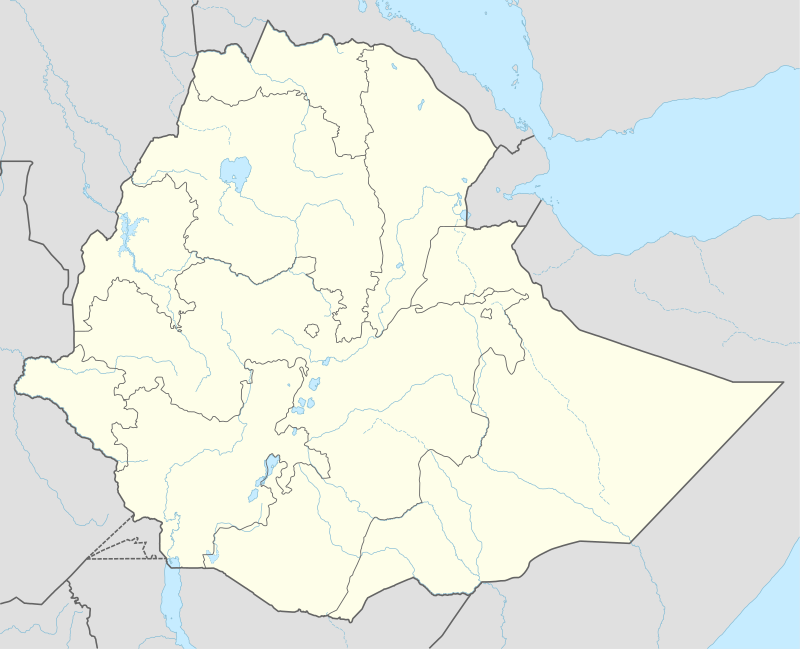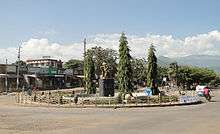Arba Minch
Arba Minch (Amharic: አርባ ምንጭ, "forty springs") is a city and separate woreda in southern Ethiopia; the first common name for this city was Ganta Garo. Located in the Gamo Gofa Zone of the Southern Nations, Nationalities, and Peoples Region about 500 kilometers south of Addis Ababa, at an elevation of 1285 meters above sea level. It is the largest town in Gamo Gofa Zone and the second town in SNNPR next to Awassa. It is surrounded by Arba Minch Zuria woreda and the most resourceful zone in southern region including two largest Lakes in Ethiopia (Chamo and Abaya), more than 40 springs, National Nech sar park, crocodile market, several fruits including banana, apple, mango, avocado, etc.
Arba Minch አርባ ምንጭ (in Amharic) Ganta Garo | |
|---|---|
City | |
 Skyline view of Arba Minch University | |
 Arba Minch Location within Ethiopia | |
| Coordinates: 6°2′N 37°33′E | |
| Country | Ethiopia |
| Region | Southern Nations, Nationalities, and Peoples |
| Zone | Gamo Gofa Omo |
| Elevation | 1,285 m (4,216 ft) |
| Population (2017) | |
| • Total | 200,373 |
| Time zone | UTC+3 (EAT) |
| • Summer (DST) | UTC+3 |
| Climate | Aw |
Overview

Arba Minch received its name for the abundant local springs which produce a groundwater forest. Located at the base of the western side of the Great Rift Valley, Arba Minch consists of the uptown administrative centre of Shecha and 4 kilometers away the downtown commercial and residential areas of Sikela, which are connected by a paved road.[1] On the eastern side of Sikela is the gate to Nechisar National Park, which covers the isthmus between Lake Abaya to the north and Lake Chamo to the south.[2] Buses and taxis connect the uptown and downtown parts; both parts have schools.[3] Kulfo River flows through the town, and drains into Lake Chamo.
Arba Minch is known as a source for fruit, including mango, banana, orange, apple, guava and pineapple, and is also known for its fish farms. Indicating its richness of fish a local singer named Abile Chedo sang the song "Nu Dere Gamo Gofa Oycha Arbaminche muziri kalsi yedes Abaya-Chamo mole". It is the home of Arba Minch University and the Southwest Synod of the Mekane Yesus Church. The town also is served by Arba Minch Airport, (ICAO code HAAM, IATA AMH).
History
Arba Minch was founded in the early 1960s by then Fitawrari Aemeroselasie Abebe and the city succeeded Chencha as the provincial capital of Gamo Gofa.[4] The oral tradition has it that Fitawrari Aemiro Selassie Abebe had to fight with prominent figures of Chencha (Aba Gaga) to move the capital from Chencha to Arbaminch. One of the reasons for Aemiroselassie Abebe to move the provincial centre from Chencha to Arbaminch was for travelers from Gidole to Chencha to take a break after a long, hot crossing of the arid Rift Valley. Roads were built linking the new town to Soddo and making Arba Minch only a day's journey by road to the capital, Addis Ababa.[4] A telephone line connecting the town to the capital, costing E$ 250,000, was turned up on 15 July 1967.[5]
The Norwegian Lutheran Mission opened a station at Arba Minch in 1970, which included a trade school; the school's operation was later taken over by the Mekane Yesus Church. At the beginning of the Ethiopian Revolution public demonstrations occurred in the town,[6] and four people were killed in clashes with the police on 28 March 1974.[5] Following the revolution privately held plantations were made into state farms.[6]
The 193 million birr Arba Minch Textile Mill was opened on 6 May 1992 in the presence of Ethiopian Prime Minister Tamirat Layne. The mill would produce polyester mixed with cotton grey fabrics.[5] According to the SNNPR's Bureau of Finance and Economic Development, as of 2003 other amenities in Arba Minch include postal service, 24-hour electrical service, a bank and a hospital.[7] May 2010, the Ethiopian Roads Authority awarded a contract worth 563 million E$ to the construction firm of Brehane Hagos to build a road 60 kilometers in length from this town to Belta.[8] The United States military operated a facility at Arba Minch from 2011 until September 2015. The facility served as the base for several General Atomics MQ-9 Reaper unmanned aerial vehicles.[9]
Demographics
Based on the 2007 Census conducted by the CSA, this town has a total population of 74,879, of whom 39,208 are men and 35,671 women. The majority of the inhabitants practiced Ethiopian Orthodox Christianity, with 56.04% of the population reporting that belief, 38.47% were Protestants, and 4.16% were Muslim. [10] In the 2012, around the town of Arba Minch, in the Arba Minch District, there were 164,529 people, of whom 82,265 were male and 82,264 were female. In this district, 53.9% practiced Protestantism, 29.3% practiced Ethiopian Orthodox Christianity, 12.6% practiced Traditional beliefs, and all other religious practices made up 4.1%.[11]
The 1994 national census reported this town had a total population of 40,020 of whom 20,096 were males and 19,924 were females.
References
- Briggs, Philip; Blatt, Brian (2009-01-01). Ethiopia. Bradt Travel Guides. ISBN 9781841622842.
- "Ethiopia: Arba Minch and Nechisar National Park Stunning Open-Air Adventures". allAfrica.com. Retrieved 2016-02-09.
- Philip Briggs, Ethiopia: The Bradt Travel Guide, 3rd edition (Chalfont St Peters: Bradt, 2002), p. 229
- Freeman, Dena (2002). Initiating change in highland Ethiopia: causes and consequences of cultural transformation. p. 37.
- "Local History in Ethiopia" The Nordic Africa Institute website (accessed 6 June 2008)
- Günther Schlee, Elizabeth E. Watson (2009). Changing identifications and alliances in North-East Africa, Volume 1. 2: Ethiopia and Kenya. Berghahn Books. p. 150.
- "Detailed statistics on hotels and tourism" Archived 2011-05-31 at the Wayback Machine, Bureau of Finance and Economic Development website (accessed 4 September 2009)
- "Tigray, Southern Towns Get First Roads", Addis Fortune 2 May 2010 (accessed 5 May 2010)
- Whitlock, Craig (4 January 2016). "Pentagon shutters African drone base, moves aircraft to other hotspots". The Washington Post. Retrieved 5 January 2016.
- Census 2007 Tables: Southern Peoples, Nations and Nationalities Region Archived November 13, 2012, at the Wayback Machine, Tables 2.1, and 3.4.
- [http://www.csa.gov.et/index.php?option=com_rubberdoc&view=doc&id=273&format=raw&Itemid=521 In 2017,in the Arba Minch District, there were 200,373 people, of whom 100,195 were male and 100,178 were female. Census 2007 Tables: Southern Peoples, Nations and Nationalities Region] Archived November 13, 2012, at the Wayback Machine, Table 3.4.
External links
| Wikivoyage has a travel guide for Arba Minch. |